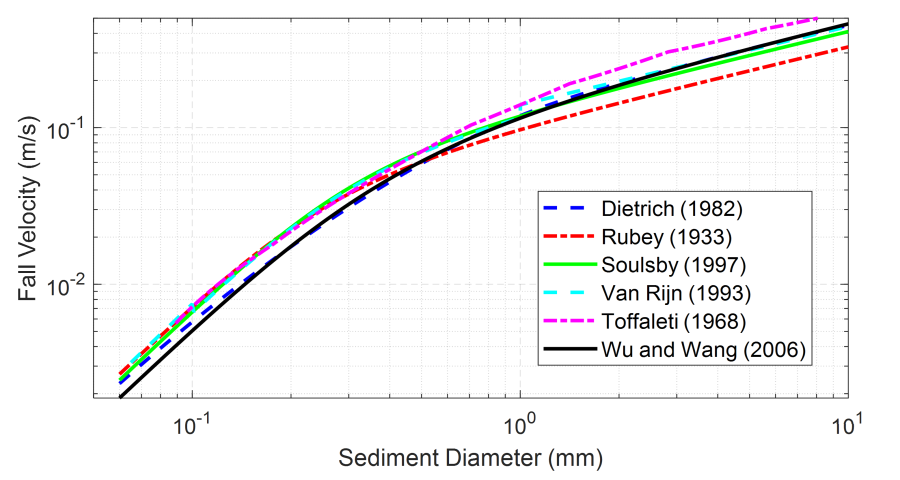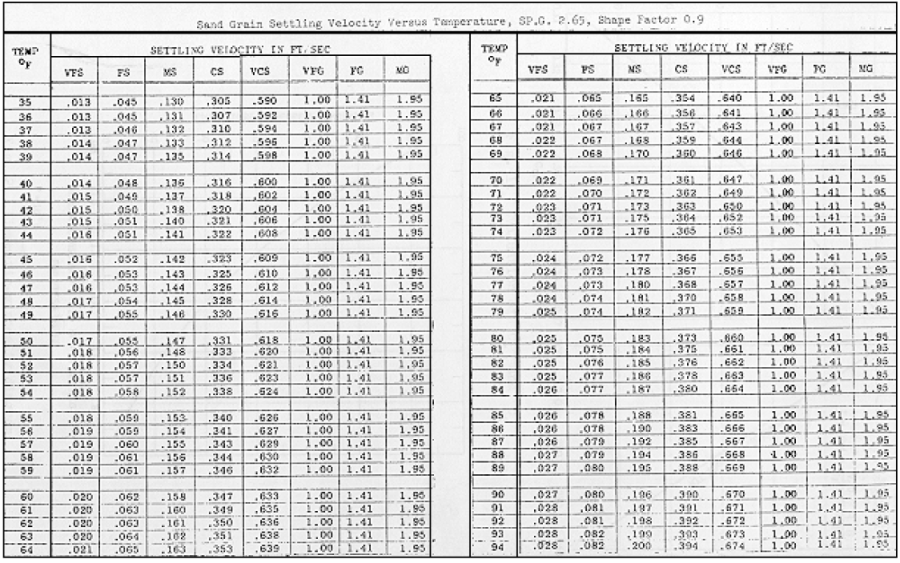Download PDF
Download page Particle Settling Velocity.
Particle Settling Velocity
For non-cohesive sediments, the sediment particles settle as individual particles and the sediment fall velocity may be determined utilizing the grain size particle. The settling velocity formulas which consider the particle shape are the Dietrich (1982) and Wu and Wang (2006). The Dietrich (1982) formula is the only one which considers the particle roundness. Of the particle settling velocity formulas available in HEC-RAS, the Rubey (1933) and Toffaleti (1968) produce the slowest and fastest velocities for particle sizes larger than 0.5 mm, respectively. The van Rijn (1993) formula has a discontinuity at a particle size of 1 mm. 
Figure 2 17. Sediment particle fall velocity formulas (assuming a water temperature is 13ºC, Corey shape factor of 0.7, specific gravity of 2.65, and a Power's roundness index of 3.5).
Dietrich
Dietrich (1982) proposed the following formula to estimate the sediment settling velocity of noncohesive particles
| 1) | \frac{\omega _{sd}^{3}}{Rg\nu }=W_{*}=R_{3}10^{{R_{1}}+{R_{2}}} |
where
R = ρ_s /ρ_w−1 = Submerged specific gravity [-]
ρ_s = particle density [M/L3]
ρ_w = pater density [M/L3]
g = gravitational constant (~9.81 m/s2) [L/T2]
\begin{aligned} \begin{array}{l} R_{1}&=-3.76715+1.92944\log _{10}D_{*}-0.09815(\log _{10}D_{*})^{2}\\ &-0.00575(\log _{10}D_{*})^{3}+0.00056(\log _{10}D_{*})^{4} \end{array} \end{aligned}
\begin{aligned} \begin{array}{l} R_{2}&=\left[\log _{10}\left(1-\frac{S_{F}}{0.85}\right)\right]-(1-S_{F})^{2.3}\tanh (\log _{10}D_{*}-4.6)\\ &+0.3(0.5-S_{F})(1-S_{F})^{2}(\log _{10}D_{*}-4.6) \end{array} \end{aligned}
\begin{aligned} \begin{array}{l} R_{3}&=\left\{0.65-\left[\frac{S_{F}}{2.83}\tanh \left(\log _{10}D_{*}-4.6\right)\right]\right\}^{1+(3.5-P)/2.5} \end{array} \end{aligned}
\begin{aligned} \begin{array}{l} D_{*}&=\frac{Rgd_{n}^{3}}{\nu ^{2}} \end{array} \end{aligned}
ν = kinematic viscosity [L2/T]
S_F = Corey (1949) shape factor (typically 0.6 - 0.7) [-]
P = Powers (1953) roundness index (typically 3.5) [-] (see also Folk 1955)
It is noted that in the Dietrich formula, the non-dimensional grain size is defined slightly differently from the other formulas. Of all the formulas available in HEC-RAS, the Dietrich formula is the only formula to consider the particle roundness by means of the Powers roundness index. The formula also considers the particle shape through the Corey shape factor.
Rubey
Rubey (1933) developed an analytical formula for the sediment fall velocity based on the sediment and fluid properties utilizing Stoke’s law for fine particles and an impact formula for large particles. The formula is given by
| 2) | \omega _{sd}=F_{1}\sqrt{Rgd} |
in which
| 3) | F_{1}=\sqrt{\frac{2}{3}+\frac{36\nu ^{2}}{Rgd^{3}}}-\sqrt{\frac{36\nu ^{2}}{Rgd^{3}}} |
and
ν = kinematic viscosity [L2/T]
g = gravitational constant (~9.81 m/s2) [L/T2]
d = grain size diameter [L]
R = ρ_s/ρ_w−1 = submerged specific gravity [-]
ρ_s = particle density [M/L3]
\rho_w= water density [M/L3]
The parameter F1 has an upper limit of 0.79 which corresponds to particles larger than 1 mm settling in water with temperatures between 10 and 25∘C. The Rubey formula is one of the earliest sediment fall velocity formulas developed. However, it tends to significant under-predict the fall velocity for sediments courser than fine sand.
Soulsby
Soulsby (1997) proposed a sediment settling velocity formula for non-cohesive sediments which includes the effects of grain size and density, water viscosity, and sediment concentration
| 4) | \omega _{sd}=\frac{\nu }{d}\left[\left(10.36^{2}+1.049d_{*}^{3}\right)^{1/2}-10.36\right] |
where
ν = kinematic viscosity [L2/T]
d = grain size diameter [L]
d_* = d(Rg)^{1/3}ν^{− 2/3} = nondimensional grain size [-]
R = ρ_s/ρ_w-1 = submerged specific gravity [-]
ρ_s = particle density [M/L3]
ρ_w = water density [M/L3]
g = gravitational constant (~9.81 m/s2) [L/T2]
Toffaleti
Toffaleti (1968) presented a table of fall velocities with a shape factor of 0.9 and a specific gravity of 2.65. Different fall velocities are given for a range of temperatures and grain sizes. These are presented in the table below. Sediment fall velocities are linearly interpolated from the values in the table below.
Table 28. Sediment fall velocities from Toffaleti (1968).

Van Rijn
Van Rijn (1993) proposed the following sediment fall velocity
| 5) | \omega _{sd}=\left\{\begin{array}{l} \frac{Rgd^{2}}{18\nu }\,\,\,\,\,\,\,\,\,\,\,\,\,\,\,\,\,\,\,\,\,\,\,\,\,\,\,\,\,\,\,\,\,\,\,\,\,\,\,\,\,\,\,\,\,\,\mathrm{for}\,\,0.065\,\mathrm{mm}\,<d\leq 0.1\,\mathrm{mm}\\ \frac{10\nu }{d}\left(\sqrt{1+0.01\frac{Rgd^{3}}{\nu ^{2}}}-1\right)\,\,\,\,\mathrm{for}\,\,0.1\,\mathrm{mm}\,<d\leq 1\,\mathrm{mm}\\ 1.1\sqrt{Rgd}\,\,\,\,\,\,\,\,\,\,\,\,\,\,\,\,\,\,\,\,\,\,\,\,\,\,\,\,\,\,\,\,\,\,\,\,\,\,\,\,\mathrm{for}\,\,1\,\mathrm{mm}\,\geq d \end{array}\right. |
where
ν = kinematic viscosity [L2/T]
d = grain size [L]
d_* = d(Rg)^{1/3}ν^{−2/3} = dimensionless grain size [-]
R = ρ_s/ρ_w-1 = submerged specific gravity [-]
\rho_s = particle density [M/L3]
ρ_w = water density [M/L3]
g = gravitational constant (~9.81 m/s2) [L/T2]
Wu and Wang
Wu and Wang (2006) proposed a formula for the sediment fall velocity which includes the particle shape:
| 6) | \omega _{sd}=\frac{M\nu }{Nd}\left[\sqrt{\frac{1}{4}+\left(\frac{4N}{3M^{2}}d_{*}^{3}\right)^{1/n}}-\frac{1}{2}\right]^{n} |
where
ν = kinematic viscosity [L2/T]
d = grain size [L]
d_{*}=d\left(\frac{Rg}{\nu ^{2}}\right)^{1/3} = nondimensional grain size [-]
R = ρ_s/ρ_w −1 = submerged specific gravity [-]
ρ_s = particle density [M/L3]
ρ_w = water density [M/L3]
g = gravitational constant (~9.81 m/s2) [L/T2]
M=53.5\exp (-0.65S_{F})
N=5.65\exp (-2.5S_{F})
n=0.7+0.9S_{F}
S_F = Corey shape factor [-] (Corey 1949)
Wu and Wang (2006) calibrated the coefficients to the natural sediment settling data from various authors with shape factors varying from 0.3 to 1.0 and a wide range of Reynolds numbers. The Wu and Wang (2006) fall velocity may be seen as a general form of the Rubey (1933), Zhang (1961), and Cheng (1997) with different values for the coefficients M, N, and n